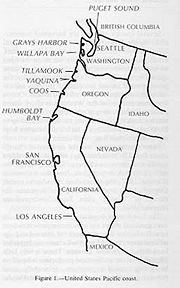Olympia Oyster
From marinelife1011
Ostrea Lurida, commonly known as the Olympia Oyster, is a bivalve native to the west coast of North America. They are found attached to the bottom and top of a variety of substrates in bays and calm estuaries. They are filter feeders, using gills to extract food from the surrounding water. Can survive in waters with varying salinity. Their shells grow to a length of 35-45mm. They are sexual reproducers. This Oysters population has been greatly exploited by the fishing industry and has still not recovered. Many Restoration and Conservation attempts have been made though, few have shown successful. These oysters are called Olympia oysters after the important 19th century oyster industry near Olympia, Washington, in Puget sound.
| Olympia Oyster | |
|---|---|
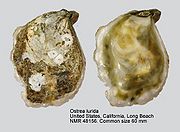 |
|
| Ostrea Lurida: Photo by Joop Trausel & Frans Slieker, taken from http://www.nmr-pics.nl/Ostreidae_new/album/slides/Ostrea%20lurida.jpg | |
| Scientific classification | |
| Kingdom: | Animalia |
| Phylum: | Mollusca |
| Class: | Bivalvia |
| Subclass: | Pteriomorphia |
| Order: | Pterioida |
| Family: | Ostreidae |
| Subfamily: | Ostreinae |
| Genus: | Ostrea |
| Species: | Lurida |
| Binomial name | |
| Ostrea Lurida Carpenter, 1864 |
|
Contents |
Phylogeny & Description
Morphology
Average length ranges from 6-8cm with a width of 4-6cm. Shell shape can vary extremely. Upper (right) valve is flat and fits into the raised area of the opposite valve. Lower (left) valve is concave and shallow. Upper and Lower valves are usually the same size. Shells growing on substrates will conform in respect to substrate. Free-growing oysters have oval to elongated shells. The exterior of the shell has no organic coating, or periostracum, and varies from white to a black purple. shells may have purplish brown or yellow stripes. The scar of the adductor muscle is not much darker then the white to olive green interior of the valves.
Anatomy
Oysters are filter feeders, drawing water in over their gills through the beating of cilia. Suspended plankton and particles are trapped in the mucus of a gill, and from there are transported to the mouth, where they are eaten, digested and expelled as faeces or pseudofaeces. In addition to their gills, oysters can also exchange gases across their mantle, which is lined with many small, thin-walled blood vessels. A small, three-chambered heart, lying under the adductor muscle, pumps colorless blood to all parts of the body. At the same time, two kidneys, located on the underside of the muscle, remove waste products from the blood. One characteristic that is unique to Olympia oysters is that they have two sexes, their reproductive organs contain both eggs and sperm. This allows Olympia Oysters to technically have the possibility to fertilize its own egg. Once fertilized, they discharge millions of eggs into the water. The larvae develop in about six hours and swim around for about two to three weeks. After that, they settle on a bed and mature within a year. (11) The average size of an Olympia oyster is 50 mm. The size refers to shell length only and gives the largest average size.
Evolution
Oysters, like clams, scallops, mussels, and the rest of the Bivalves are a altered group of mollusks. Bivalves are some of the earliest mollusks to be seen evolutionarily. Numerous bivalves, including Fordilla and Pojetaia, date back to the Tommotian Period which is about 535-521 million years ago. Although these bivalves disappeared during the mid-Cambrian period, around 510-501 million years ago, modern bivalves were seen in the early Ordovician period 488-472 million years ago. These dates are based on accumilated fossil records. Bivalves were seen evolving during the early paleozoic and mesozoic around 251-65.5 million years ago.
Ecology & Distribution
Geographic Range
The olympia oyster is native to the Puget Sound, but range from Baja California to Southern Alaksa. It was once plentiful on the west coast, from Sitka, AK to Baja California. Fossil records show presence in mid-California as early as the Miocene and early-Pliocene. Native Indians and early americans may have been responsible for changes in their geographic range. Therefore, by the early 1930's, this oysters natural range had been diminished. It is also indicated by historic evidence that this oyster is indigenous to at least three of Oregon's estuaries. The Yaquina Bay, the Netarts Bay, and Coos Bay, though it seems only the Yaquina Bay population has been continuous since prewestern settlements. This information is backed by large shell deposits buried in the sediment of the polyhaline estuary regions and by numerous fishery landing records in those areas. Other Oregon estuaries such as Umpqua/Winchester, Alsea, and Tillamook Bay might have also sustained populations of Ostrea Lurida.
Habitat
Can be found growing on pilings, rocks, docks, floats, and on other oyster shells close to low-tide areas in calm estuaries and bays. Can also be found living in small rivers and streams. In higher elevations they are found in mudflat bordered areas. In lower elevations they live in eel grass beds. They need water with temperatures from 6-20 degress celsius and depths of 0-71 meters. They live in waters with an average salinity of 25ppt though, can survive in streams where salinity fluxuates. These oysters are vulnerable to extreme high and low temperatures.
Olympia Oysters are usually found on rocky substrates near the low tide line or on mud flats and gravel bars in quiet bays with low salinities. (12) A group of these or any other oysters is commonly called a bed or oyster reef. These oyster reefs actually provide habitat for many other marine species. The hard surfaces of these oyster shells and the nooks between the shells provide places where a host of small animals can live. Hundreds of animals such as sea anemones, barnacles, and hooked mussels inhabit these oyster reefs.(11)
Life History
The Olympia oysters life history is similar to the other oysters of the genus Ostrea. It is indicated by historical evidence that this oyster is indigenous to at least three of Oregon's estuaries. Fossil records and sedimentation along the North American coast show they are native to these waters. Some records may be shown unaccurate due to native indian cultivations effecting Ostrea Lurida populations and their natural flourishing sites.
Decline
Ostreola conchaphila nearly disappeared from San Francisco Bay following overharvest during the California Gold Rush (1848-50s) and massive silting from hydraulic mining in California's Sierra Nevada (1850s-1880s). California's most valuable fishery from the 1880s-1910s was based on imported Atlantic oysters, not the absent native. But in the 1990s, O. conchaphila once again appeared in San Francisco Bay, surprisingly in some of the most polluted waters of the bay near the Chevron Richmond Refinery in Richmond, California. Currently the Olympia oyster populations have been decimated by overfishing, introduced species, habitat loss, and disease. (14)
Reproduction and Behavior
Reproduction
The spawning process begins at water temperatures of 13-16 Celsius. Clusters of Sperm are released in the mantle cavity of the males. Contractions of the shell are used by the body to expel these balls. The sperm disintegrates in seawater and spermatozoa is released. The female bring the spermatozoa into the mantle cavity using water pumps. The eggs are then fertilized. Spermatozoa in seawater stimulates synchronous spawning in other Olympia oysters. Veliger larvae develop from the fertilized eggs within the mantle chamber and are discharged 10-12 days later. They develop feet and an eyespot within the 11-16 day veliger stage. Then they metamorphose into spat after crawling on hard substrate. This substrate can range from old oyster shells, rocks, wood, metal, to any other hard material. Due to the swimming position of larvae, the foot being held in a superior position, oyster spat set on the underside and upperside of horizontal surfaces. In the northern area of the oysters geographic range, there may be one or two spawning periods in mid-summer. In the central area of their geographic range, spawning may be one prolonged period or two in mid-summer. In the Southern area, spawning occurs from spring to fall, peaking in the spring.
Life Span
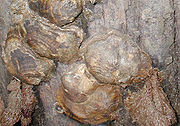
After larvae have been released from female they go through a 11-16 day veliger stage while in search of substrate to live on (See Reproduction). Once larvae have found substrate to live on and have metamorphosed from larvae to spat, shell begins to grow. Oysters grow slow, their shells reaching 35-45mm in three years within Washington. After this three year period, there is little to no increase in growth. As the oyster matures, shell growth decreases. Although shells have been recorded to grow to heights of 50mm. The maximum size of an Olympia oyster recorded was 75mm.
Feeding
Similar to other bivalves, they are filter feeders which filter the water that surrounds them screening out phytoplankton which they eat. These phytoplankton are found in tidal waters. They filter 9-12 quarts of water daily. In turn, marine waters are kept clean. The water is filtered through ostia-gill openings which are larger on the olympia oyster than the japanese oyster. This larger ostia-gill allows for larger food items and prevents it from consuming nannoplankton. The position of the two mantles coming together considerably reduces the amount of water taken in by gills. Temperature and Salinity of surrounding water effects the oysters ability to feed. When temperatures are low, the shell is forced to close therefore effecting suction of gills. This is the case since the behavior of the adductor muscle is controlled by temperature. The gills, mantle, and adductor muscle are the three sets of organs which control feeding. The ciliae covering the surface of the gills influences the rate of feeding. The ciliaes synchronous beating forces the water through the gills. Therefore, stronger ciliae means improved eating.
Human Use
Fisheries
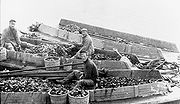
The Olympia oyster has supported an Indian sustenance fishery and a commercial fishery, and was used to establish a maricultural industry on the US west coast. They were shown to be an important food item of coastal tribes by the large quantity of shells found in San Francisco Indian kitchen middens. Indians of the southern puget sound located their settlements near oyster populations. In Washington in 1850, 10,000 bushels of wild Olympia oysters were harvested. Production had reached 130,000 bushels a year by the 1890's. In 1910, production declined to 16,000 bushels a year due to Callow Act of 1890 which allowed private ownership of tidelands. Oysters were returned to reefs which would in turn produce new generations. During the early 1900's, dyked oyster beds were created with gravel bottoms which held water at low tides. After 3 to 5 years, oysters reached a marketable size and then were sold as shucked meat rather them in the shell. This led to increases in oyster culture. Production peaked in 1897 to 1908, at 63,000 gallons a year. Production declined in the 1920's to 42,000 gallons a year and continued to fall through the 1980's. This decline was due to anthropogenic pollution along with urbanization.
Functions and Uses
Olympia Oysters as well as oysters in general consume nitrogen-containing compounds (nitrates and ammonia), removing them from the water. Nitrogen compounds are important phytoplankton nutrients. Phytoplankton increase water turbidity. Limiting the amount of phytoplankton in the water improves water quality and other marine life by reducing competition for dissolved oxygen. Oysters feed on plankton, incidentally consuming nitrogen compounds as well. They then expel solid waste pellets which decompose into the atmosphere as nitrogen. (11)
Olympia Oysters are also used for human consumption. The importance of oysters as a food in many cultures dates back as far as prehistoric Roman and early United kingdom traditions. "Oysters, especially 'wild', are excellent sources of several minerals, including iron, zinc and selenium, which are often low in the modern diet. They are also an excellent source of Vitamin B12. Oysters are considered the healthiest when eaten raw on the half shell." Jonathan Swift. Olympia oysters in particular proved extremely important for the Native Americans on the west coast. American peoples consumed O. conchaphila everywhere it was found, with consumption in San Francisco Bay so intense that enormous middens of oyster shells were piled over thousands of years. (13)
Conservation & Preservation
Conservation/Preservation
Conservation measures have been made due to the exploitation of Ostrea Lurida. Oyster conservation was one of the first measures addressed in 1889 after statehood was granted. The first legislature passed an act regulating the appraisal and disposal of tidelands. The Callow Act and Bush Act were also passed to support cultivation of oysters. Many oyster reserves were created by Washington legislature in 1890 and 1910. These reserves overlapping already existing natural oyster beds. 4,500 acres in Puget Sound and 11,239 acres in Willapa Bay were used as reserves. These reserves were not fully protected and still experienced exploitation. Today the reserves popularity and interest has greatly decreased. Only 10,000 acres reserves in Willapa Bay and 1,000 acres of reserves in Puget Sound still exist today.
Restoration
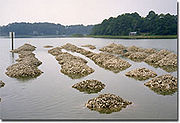
Restoration interest has increased due to oyster growers, nonprofit organizations, state agencies, and tribes. Restoration supports a range of interests including improved water quality, a habitat for other native species, and possible commercial harvests. In 1970, Ostrea Lurida was recognized as a threatened species candidate by Washington State. In 1998 a Stock Rebuilding plan was created for the species. The plan involves habitat recovery and the planting of juvenile hatchery raised oysters. The Habitat recovery consists of the natural recruitment of placed shells. There are at least 41 restoration sites in Washington. These sites have been constructed out of the Puget Sound Restoration fund. The plan aims to restore and preserve populations on public tidelands of their natural range. Restoration sites that have been successful are usually subtidal or moist seeps which prevent predation. These areas also protect the oysters from silt. Biology of the Olympia oyster is being studied to further understand its relationship with the environment. Information gained through these studies will go to support restoration.
Species restoration projects for the Olympia oyster funded by the U.S. Government are active in Puget Sound and San Francisco Bay.[12][13] An active restoration project is taking place in Liberty Bay, Washington.[14] This Puget Sound location is the home of an old and new Olympia oyster population. The re-establishment of the population is currently threatened by the invasive Japanese oyster drill Ocinabrina inorata. This species preys on the oysters by drilling a hole between the two valves and digesting the oyster's tissues. O. inorata is a threat to the oyster especially in areas with low populations of the mussel Mytilis. The Nature Conservancy of Oregon also has an ongoing restoration project at Netarts Bay, Oregon.[15] (13)
References
1. "Operating System". Facebook. 2011. Retrieved 2/21/11 from http://en-gb.facebook.com/pages/Ostrea-lurida/110536608974630?sk=info
2. Phipps, Melissa & Telnack, Jennifer. Ostrea Lurida, Olympia Oyster. Intertidal Marine Invertebrates of the South Puget Sound. Retrieved 2/19/11 from http://www.nwmarinelife.com/htmlswimmers/o_lurida.html
3. Couch, D., and T.J. Hassler. 1989. Species profiles: life histories and environmental requirements of coastal fishes and invertebrates (Pacific Northwest)--Olympia oyster. U.S.Fish Wildl. Serv. Biol. Rep. 82(11.124). U.S. Army Corps of Engineers, TR EL-82-4. 8 pp.
4. Groth, S. & Rumrill, S. History of Olympia Oysters in Oregon estuaries and a description of recovering populations in Coos Bay. Journal of Shellfish Research 2009 vol.28 No.1 pp. 51-58. Retrieved 2/21/11 from http://www.cabdirect.org/abstracts/20093118284.html
5. Polson, Maria P. & Zacherl, Danielle C. Geographic distribution and intertidal population status for the Olympia oyster, Ostrea lurida Carpenter 1864, from Alaska to Baja. Journal of Shellfish Research. March 1, 2009. Retrieved 2/21/11 from http://www.highbeam.com/doc/1G1-198995402.html
6. White, Jacqueline & Ruesink, Jennifer & Trimble, Alan. The nearly forgotten oyster: Ostrea Lurida Carpenter 1864 (Olympia Oyster) history and management in Washington State. Department of Biology, University of Washginton. National Shellfisheries Association, Inc. 2009. Retrieved 2/21/11 from http://www.thefreelibrary.com/The+nearly+forgotten+oyster%3A+Ostrea+lurida+Carpenter+1864+(Olympia...-a0198995399
7. Galtsoff, Paul S. March 1936. Biology of the Oyster in Relation to Sanitation. U.S. Bureau of Fisheries, Washington, D.C. Vol.26, pp. 245-247. Retrieved 2/21/11 from http://ajph.aphapublications.org/cgi/reprint/26/3/245.pdf
8. Glude, John B. Recent Developments in Shellfish Culture on the U.S. Pacific Coast. National Marine Fisheries Service. Retrieved 2/21/11 from http://www.lib.noaa.gov/retiredsites/japan/aquaculture/report1/1ujnr33.jpg&imgrefurl=http://www.lib.noaa.gov/retiredsites/japan/aquaculture/report1/glude.html&usg=__E8VofoY71X7DRBIbPLdbUBiGfas=&h=410&w=256&sz=17&hl=en&start=6&zoom=1&um=1&itbs=1&tbnid=jH2QIoipY5r2bM:&tbnh=125&tbnw=78&prev=/images%3Fq%3Dostrea%2Blurida%2Breproduction%26um%3D1%26hl%3Den%26client%3Dsafari%26sa%3DN%26rls%3Den%26ndsp%3D20%26tbs%3Disch:1&ei=iGJjTd7yDoqisAO_h8jBCA
9. Trausel, Joop & Slieker, Frans. Ostrea Lurida. Natural History Museum Rotterdam. Retrieved 2/21/11 from http://www.nmr-pics.nl/Ostreidae_new/album/
10. Linkonis, Robert. May 13, 2009. Oyster Management and Restoration. A Virginia Oyster Lovers Paradise. Retrieved 2/21/11 from http://oysterloversparadise.blogspot.com/2009/05/oyster-management-and-restoration.html
11. Elkhorn Slough Research: Native Oysters at Elkhorn Slough. Elkhorn Slough. Retrieved 2/22/11 from http://www.elkhornslough.org/sloughlife/inverts/olympia_oyster.htm
12. http://en.wikipedia.org/wiki/Oyster#Habitat_and_behaviour
14. http://en.wikipedia.org/wiki/Olympia_oyster
15. RestoringSouthern California Estuaries through Public-Private Partnerships: Developing Sustainable Aquaculture for an Ecosystem Engineer, the Native California Oyster, Ostreola conchaphila Group Project Proposal 2007
